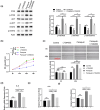Paraquat disrupts the blood-brain barrier by increasing IL-6 expression and oxidative stress through the activation of PI3K/AKT signaling pathway
- PMID: 39291284
- PMCID: PMC11406143
- DOI: 10.1515/med-2024-1020
Paraquat disrupts the blood-brain barrier by increasing IL-6 expression and oxidative stress through the activation of PI3K/AKT signaling pathway
Abstract
Background: Paraquat (PQ) is a frequently used herbicide with neurotoxic effects after acute or chronic exposure. Although in vitro evidence supports the PQ toxicity to dopamine cells, its in vivo effects (especially the chronic exposure) remain ambiguous. In this study, we investigated the effect of chronic PQ exposure on the blood-brain barrier (BBB) damage and the underlying mechanisms.
Methods: Adult male Sprague Dawley rats and primary human brain microvascular endothelial (PHBME) cells were exposed to PQ as the animal and cell models. Evans Blue staining and hematoxylin & eosin staining were conducted to examine the BBB and brain tissue damages. The inflammatory cytokines were quantified via enzyme linked immunosorbent assay. The changes of PI3K/AKT signaling pathway were detected by western blot.
Results: PQ exposure can cause significant pathological lesions in the brain tissues and the BBB. IL-6 and reactive oxygen species levels were found to be significantly upregulated after PQ exposure in both the animal and cell models. PQ treatment could arrest the cell proliferation and migration in PHBME cells. PQ treatment promoted the phosphorylation of PI3K and AKT, and the application of PI3K inhibitor could attenuate PQ-induced IL-6 production, oxidative stress, BBB disruption, and brain tissue damage.
Conclusion: Our study demonstrated that chronic PQ exposure could impair the BBB function and induce brain tissue damage. The overactivation of the PI3K/AKT pathway, consequent upregulation of IL-6 production, and increased oxidative stress appear to mediate the inflammatory damage resulting from PQ exposure.
Keywords: BBB; IL-6; PI3K/AKT signaling; inflammation.; paraquat.
© 2024 the author(s), published by De Gruyter.
Conflict of interest statement
Conflict of interest: The authors of this study promise to be free of any conflicts of interest.
Figures





References
-
- Song CY, Feng MX, Li L, Wang P, Lu X, Lu YQ. Tripterygium wilfordii Hook. f. ameliorates paraquat-induced lung injury by reducing oxidative stress and ferroptosis via Nrf2/HO-1 pathway. Ecotoxicol Environ Saf. 2023 Mar;252:114575. - PubMed
-
- Liu Z, Huang F, Zhao S, Ma L, Shi Q, Zhou Y. Homicidal paraquat poisoning: poisoned while drinking. J Forensic Sci. 2022 May;67(3):1312–9. - PubMed
LinkOut - more resources
Full Text Sources
